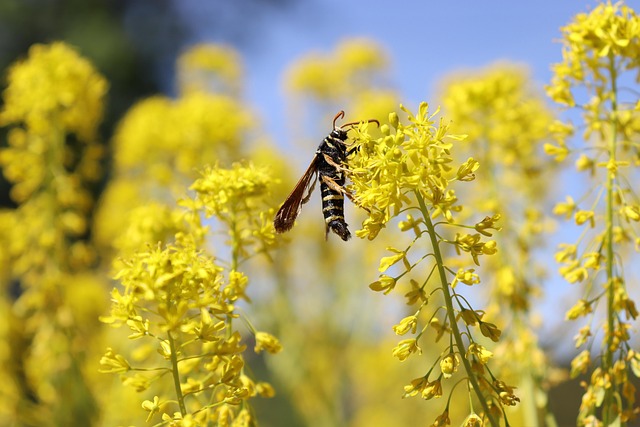Yellow jackets, aggressive social wasps common during warmer months, pose significant pest concerns. Effective long-term control involves identifying nesting sites, sealing entry points, using baits, and manipulating habitats. Customized prevention plans break the pest life cycle, reduce chemical exposure, and prioritize human health, ensuring safe coexistence with yellow jackets. This strategy includes professional inspections, tailored exclusion methods, integrated pest management (IPM), regular maintenance, and continuous collaboration between homeowners and professionals for optimal results in yellow jacket control services.
“Unwanted yellow jackets can disrupt outdoor activities and pose health risks. To effectively manage these persistent pests, tailored long-term prevention plans are essential. This article explores comprehensive strategies for yellow jacket control services, focusing on understanding their behaviors and the benefits of custom solutions. We’ll delve into key components, from habitat modification to targeted treatments, ensuring successful, ongoing protection. By implementing these customized plans, property owners can enjoy a peaceful outdoor environment, free from the hassle of yellow jackets.”
Understanding Yellow Jackets and Their Behaviors
Yellow jackets are social wasps known for their aggressive behavior and stinging abilities, making them a common pest concern, especially during the warmer months. Understanding their behaviors is crucial when developing long-term prevention strategies. These insects live in colonies with a queen who lays eggs, and workers that gather food, feed larvae, and protect the nest. They are attracted to sweet substances, which is why they often buzz around fruit, soda cans, or any open containers with sugary drinks.
Identifying their preferred nesting sites—such as empty spaces in walls, attics, or trees—is key to prevention. Yellow jacket control services employ specialized techniques like inspecting and sealing entry points, using baits to disrupt colony growth, and implementing habitat manipulation strategies to deter these wasps from settling in desirable areas. By combining these methods with regular maintenance and inspections, long-term yellow jacket prevention plans can be effective in creating a safer environment for both homes and businesses.
Benefits of Customized Long-Term Prevention Plans
Customized long-term prevention plans offer several significant advantages when it comes to managing and controlling yellow jackets, providing a more effective and sustainable solution than generic, one-size-fits-all approaches. These tailored strategies are designed to address the specific needs and challenges posed by yellow jacket infestations in various environments. By taking into account factors like habitat, local regulations, and unique ecological considerations, yellow jacket control services can develop comprehensive plans that target these pests humanely and efficiently.
One of the key benefits is their ability to prevent re-infestations over an extended period. Unlike quick-fix solutions, which often only suppress yellow jackets temporarily, these customized plans focus on breaking the pest life cycle at its source. This long-term strategy not only minimizes the need for frequent treatments but also reduces environmental impact by limiting exposure to chemicals and promoting ecologically balanced control methods. Such proactive measures ensure a safer, more harmonious coexistence with these insects while safeguarding human health and well-being.
Key Components of an Effective Customized Plan
An effective customized plan for long-term yellow jacket prevention is a multi-faceted approach that integrates several key components. The first step involves a thorough inspection and assessment by professional yellow jacket control services, who can identify potential entry points, nesting sites, and active colonies within your property. This detailed analysis forms the backbone of your tailored strategy.
Additionally, these plans often include a combination of exclusion methods, such as sealing gaps and installing screens, to prevent wasps from entering homes or buildings. Integrated pest management techniques are also crucial, employing eco-friendly solutions like targeted treatments, traps, and regular monitoring to disrupt breeding cycles without harming beneficial insects. Regular maintenance and seasonal adjustments further ensure the plan remains effective over time, addressing evolving wasp behaviors and habitat changes.
Implementation and Ongoing Support for Yellow Jacket Control Services
Implementing a customized plan for long-term yellow jacket control services requires a collaborative effort between professionals and homeowners. Once a tailored strategy is in place, regular communication becomes vital to ensure its success. Homeowners should expect ongoing support from their pest control specialists, who can provide guidance on maintaining the environment and making adjustments as needed. This proactive approach includes seasonal check-ins, where experts assess the situation, address any emerging issues, and offer recommendations for prevention measures.
By fostering a partnership with yellow jacket control services, homeowners gain access to continuous learning opportunities about these pests’ behavior and habitat preferences. Regular updates on new techniques and products ensure that the control methods remain effective over time. This ongoing support is essential for maintaining a comfortable living environment, minimizing potential risks associated with yellow jackets, and promoting ecological balance.
Implementing customized long-term prevention plans, tailored to address specific yellow jacket behaviors, offers a sustainable solution for property owners. By focusing on key components like habitat manipulation, pest exclusion techniques, and regular monitoring, these strategies provide effective yellow jacket control services while promoting a safer, more enjoyable outdoor environment. With ongoing support from professionals, these plans ensure peace of mind, knowing that your space is protected from these persistent pests.
